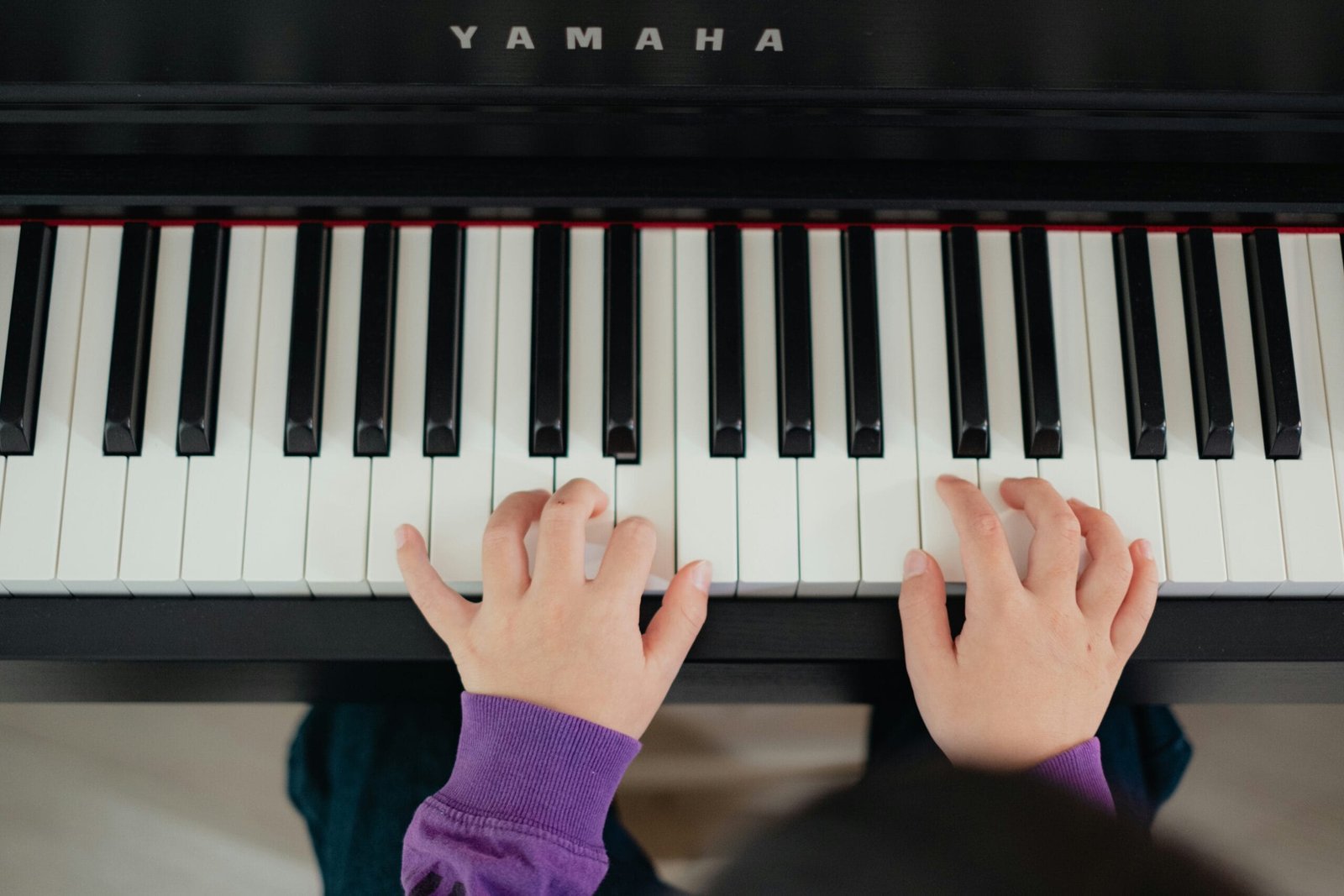Understanding the Piano: Basics for Beginners
For those embarking on the journey of piano learning, it is crucial to develop a foundational understanding of this versatile instrument. A piano comprises several essential components, including the keyboard, pedals, and the body. The keyboard itself is a series of keys, typically 88 in total, divided into white and black keys. The white keys correspond to natural notes, while the black keys represent sharps and flats, providing a complete scale that allows for musical expression.
There are various types of pianos available to learners, including grand pianos, upright pianos, and digital keyboards. Grand pianos are often favored for their tonal quality and responsiveness, making them popular in concert settings. In contrast, upright pianos are more compact, making them ideal for home use. Digital keyboards offer versatility and portability, with the additional benefit of volume control and various built-in instrument sounds, which can be appealing to beginners.
Familiarity with the piano keyboard is vital for beginners. Each key corresponds to a specific note, and understanding the placement of notes is essential for playing. The concept of octaves is equally important, as the piano is built upon the repetition of note patterns across different octaves. An octave consists of eight notes, with the first and eighth notes having the same name, albeit at different pitches. Recognizing octaves helps beginners to navigate the keyboard more efficiently and aids in the development of ear training.
Moreover, becoming acquainted with basic terminology is fundamental for effective communication regarding piano playing. Terms such as “tempo,” “dynamics,” and “articulation” will frequently arise during lessons and practice sessions. A solid grasp of these elements not only enhances musical understanding but also fosters a productive learning environment. Prioritizing these foundational aspects will ensure that beginners are well-prepared as they advance in their piano studies.
Choosing the Right Learning Method
Learning to play the piano is an exciting journey that can be undertaken through various methods, each offering distinct advantages and challenges. Aspiring pianists must evaluate these methods carefully to find a suitable approach that aligns with their personal preferences and learning goals.
Traditional piano lessons, typically conducted in-person with a qualified instructor, provide structured learning and immediate feedback. This method is advantageous for students who thrive in a one-on-one environment and benefit from personalized guidance. The discipline of scheduled lessons fosters accountability and helps in establishing a consistent practice routine. However, the cost of private lessons can be prohibitive for some, and scheduling conflicts may arise. Additionally, the pace of learning may be dictated by the instructor’s teaching style, which may not always align with the student’s individual needs.
Online courses have surged in popularity, providing accessibility to a wide variety of instructional materials and resources. Platforms such as video tutorials, interactive courses, and online communities can offer comprehensive learning experiences at a fraction of the cost of traditional lessons. This method allows for flexibility, enabling students to learn at their own pace and revisit challenging concepts as needed. On the downside, self-guided learning can sometimes lead to a lack of discipline and motivation, especially without external accountability.
Mobile apps have also emerged as a popular resource for piano learners. These applications often include gamified lessons that make learning feel engaging and enjoyable. They can be particularly beneficial for beginners who are exploring their interest in music without a significant commitment. Nevertheless, they may not provide the depth of instruction that an experienced teacher can offer, potentially leaving gaps in crucial music theory and technique.
For those with self-motivation, self-teaching through instructional books and online resources can be an effective method. This approach allows learners to tailor their study schedule and focus on specific areas of interest or challenge. However, without structured guidance, it may be easy to develop improper techniques or habits that could hinder progress.
Ultimately, the choice of learning method will largely depend on individual preferences, budget considerations, and learning styles. By comparing these options thoroughly, aspiring pianists can select a learning approach that best suits their needs, ensuring that their journey into the world of music is both enjoyable and fruitful.
Developing Practice Routines and Techniques
Establishing a structured practice routine is vital for beginners learning piano. A well-planned regimen not only facilitates progress but also enhances motivation and discipline. To create an effective practice schedule, beginners should consider incorporating specific focus areas such as technique, sight-reading, and ear training. A balanced approach helps ensure comprehensive skill development.
To initiate a practice routine, it is beneficial to set achievable goals. For instance, a beginner might aspire to master a simple piece or improve their finger agility within a set timeframe. Breaking down larger objectives into smaller, manageable tasks can make the learning process less overwhelming. For example, dedicating a session to practicing scales for fifteen minutes can provide substantial improvements in technique over time. This focused practice enables learners to build muscle memory and finger strength, essential components of becoming proficient at the instrument.
Discipline plays a crucial role in maintaining a consistent practice schedule. Even short daily sessions can yield more significant results than sporadic, lengthy practices. Setting aside the same time each day helps to cultivate a habit, making it easier to stick to the routine. It is advisable to approach each session with a clear plan, listing the specific techniques or materials to be practiced. This focus ensures that each practice time is used effectively, preventing aimless playing that does not contribute to skill improvement.
In addition to dedicated practice, integrating various exercises and methodologies can help reinforce learning. Utilizing sight-reading books can improve reading skills, while engaging in ear training exercises such as identifying intervals or chords enhances musicality. By diversifying practice techniques, beginners can create a rich learning environment that fosters joy and accomplishment in their piano journey.
Finding Resources and Communities for Ongoing Support
Embarking on a piano learning journey can be both exciting and challenging. To enrich this experience, it is essential to tap into a variety of resources and communities dedicated to supporting self-learners. The myriad of online tutorials offers a wealth of information, catering to different skill levels and learning styles. Websites such as YouTube feature numerous channels that provide step-by-step lessons, song tutorials, and valuable tips on piano techniques. These resources can be particularly beneficial for beginners seeking a visual and auditory approach to learning.
Additionally, the availability of free sheet music online allows learners to practice a wide range of pieces. Platforms like IMSLP (International Music Score Library Project) offer an extensive collection of sheet music that spans various genres and difficulty levels. Accessing this material enables students to explore different musical styles and find pieces that resonate with their personal tastes, thereby enhancing their motivation to practice consistently.
Engaging with forums and online communities can also provide a significant boost to a beginner’s learning process. Platforms such as Reddit and various music-specific forums allow individuals to connect with fellow piano enthusiasts, share their progress, and seek advice. Participating in discussions can offer insights into overcoming challenges and discovering effective practice methods. Furthermore, these communities are often rich with encouragement, which can be invaluable during times of self-doubt or frustration.
Lastly, local music communities and clubs present opportunities for in-person interaction and mentorship. Joining a piano class or visiting local music stores can foster connections with instructors and seasoned players. These interactions can lead to enriched learning experiences through feedback and moral support. As aspiring pianists continue on their musical path, utilizing these resources and engaging with supportive communities will enhance their skill development and inspire a lifelong love for playing the piano.






